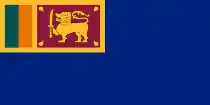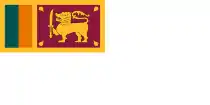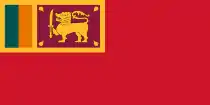Flag of Sri Lanka
The flag of Sri Lanka (Sinhala: ශ්රී ලංකාවේ ජාතික කොඩිය, romanized: Śrī Laṃkāvē jāthika kodiya; Tamil: இலங்கையின் தேசியக்கொடி, romanized: Ilankaiyin teciyakkoṭi), also called the Sinha Flag or Lion Flag, consists of a golden lion holding a kastane sword in its right fore-paw in a maroon background with four gold bo leaves, one in each corner. This is bordered by gold, and to its left are two vertical stripes of equal size in teal and orange, with the orange stripe closest to the lion. The lion and the maroon background represent the Sinhalese, while the saffron border and four bo leaves represent concepts of mettā, karuṇā, muditā and upekshā respectively. The stripes represent the country's two largest minorities, with the orange representing the Tamils living in Sri Lanka – both the Sri Lankan Tamils and the Indian Tamils of Sri Lanka – and the green stripe representing the Sri Lankan Moors (Muslims of Sri Lanka). The golden yellow border represents the other minority communities of the country.
 | |
| Sinha Flag Lion Flag | |
| Use | Civil and state flag, civil ensign |
|---|---|
| Proportion | 1:2 |
| Adopted | 22 May 1972 |
| Design | A golden field with two panels: the smaller hoist-side panel has only two vertical bands of teal and orange and the larger fly-side panel is the maroon field depicting the golden lion holding the kastane sword in its right fore paw in the center and four bo tree (bodhi tree) leaves on each corner and the golden field appears as a border around the entire flag and extends in between the two panels, all bordering together. |
 | |
| Use | Auxiliary ensign used by merchant ship commanded by reserve naval officer |
| Proportion | 1:2 |
| Adopted | 1972 |
| Design | A blue field with the flag of Sri Lanka in the canton. |
 | |
| Use | President's Colour |
| Proportion | 1:2 |
| Adopted | 1972 |
| Design | A defaced flag of Sri Lanka with Coat of arms of Sri Lanka |
 | |
| Use | Naval ensign |
| Proportion | 1:2 |
| Adopted | 1972 |
| Design | A white field with the flag of Sri Lanka in the canton. |
 | |
| Use | Civil ensign |
| Proportion | 1:2 |
| Adopted | 1972 |
| Design | A red field with the flag of Sri Lanka in the canton. |
It was officially adopted in 1972.
History
The symbol of a lion in Sri Lankan heraldry dates back to 486 BC, when Vijaya, the first King of Sri Lanka, arrived on the island from India and brought with him a standard depicting a lion.[1] The symbol appears to have influenced subsequent monarchs, being used extensively by them and becoming a symbol of freedom and hope. As depicted on a mural in Cave no. 2 at Dambulla Viharaya, King Dutugemunu on his campaign against Ellalan- an invading South Indian ruler- in 162 BC is depicted with a banner containing a lion figure carrying a sword in its right forepaw, a symbol of the Sun and one of the Moon.[1] This flag was known as the only ancient representation of the lion flag of the Sinhalese but in 1957, the lion figure on it was defaced by a vandal.[2]
This basic design continued to be in use until 1815, when the Kandyan Convention ended the reign of the country's last native monarch, Sri Vikrama Rajasinha, replacing his royal standard (used as the Flag of the Kingdom of Kandy) with the Union Flag as the nation's accepted flag.[1] The government of British Ceylon later established its own flag, while Sri Vikrama Rajasinha's standard was taken to England and kept at the Royal Hospital Chelsea.[1]
As the independence movement in Sri Lanka gained strength in the early 20th century, E. W. Perera and D. R. Wijewardena discovered the original Lioness Flag in Chelsea.[1] A photo of it was published in Dinamina, in a special edition marking a century since the loss of self-rule and Sri Lankan independence.[1] The flag provoked much interest from the public who, for the first time since the fall of the Kandyan Kingdom, had seen its actual design.[1]
Member of Parliament for Batticaloa, Mudaliyar A. Sinnalebbe, suggested in Parliament on January 16, 1948, that the Lion Flag should be accepted as the national flag.[3] In 1948, the flag was adopted as the national flag of the Dominion of Ceylon, undergoing two changes: one in 1953 and a redesign in 1972.[1] A notable feature of 1972's adaptation of the Kandyan standard was the replacement of the four spearheads at the flag's corners by four bo leaves, a design choice made under the direction of Nissanka Wijeyeratne, Permanent Secretary to the Ministry of Cultural Affairs and Chairman of the National Emblem and Flag Design Committee.[1][4]
- Monarchical Sri Lanka
- Historical flags of Sri Lanka

 Flag of Dutugamunu, Anuradhapura period
Flag of Dutugamunu, Anuradhapura period
 Flag of Kingdom of Gampola's flag, c.1341–1408
Flag of Kingdom of Gampola's flag, c.1341–1408
 Flag of the Kingdom of Kotte's flag, c.1412–1597
Flag of the Kingdom of Kotte's flag, c.1412–1597.png.webp)
 Flag of Kingdom of Sitawaka's flag, c.1521-1594
Flag of Kingdom of Sitawaka's flag, c.1521-1594
 Standard of Sri Vikrama Rajasinha of Kandy, used as the Kingdom of Kandy's flag, c.1798–1815
Standard of Sri Vikrama Rajasinha of Kandy, used as the Kingdom of Kandy's flag, c.1798–1815
- British Ceylon period
- Historical flags of Sri Lanka

 Flag of British Ceylon, 1815–1875
Flag of British Ceylon, 1815–1875.svg.png.webp)
 Flag of British Ceylon, 1875–1948
Flag of British Ceylon, 1875–1948
- Sri Lanka (since 1948)
- Historical flags of Sri Lanka
.svg.png.webp)
 Flag of the Dominion of Ceylon, 1948–1951
Flag of the Dominion of Ceylon, 1948–1951.svg.png.webp)
 Flag of the Dominion of Ceylon (similar to current), 1951–1972
Flag of the Dominion of Ceylon (similar to current), 1951–1972
Symbolism
The national flag of Sri Lanka represents the country and its heritage as a rallying device. Most symbols in the flag have been given distinctive meanings.[5][6]
| Symbol | Represents |
|---|---|
| The Lion | The Sinhala ethnicity and the strength of the nation |
| The bo leaves | The four Buddhist virtues of loving-kindness, compassion, sympathetic joy and equanimity |
| The sword of the lion | The sovereignty of the nation |
| The curly hair on the lion's head | Religious observance, wisdom and meditation |
| The eight hairs on lion's tail | The Noble Eightfold Path |
| The beard of the lion | Purity of words |
| The handle of the sword | The elements of water, fire, air and earth |
| The nose of the lion | Intelligence |
| The two front paws of the lion | Purity in handling wealth |
| Orange stripe | The Tamil ethnicity (including the Hill Country Tamils of Indian ancestry) |
| Teal stripe | The Moor ethnicity |
| Saffron border | Buddhism and unity among the people |
| The maroon background | The Sinhala ethnicity |
| The golden yellow border | Other minority communities of Sri Lanka, such as the Malays, the Burghers, the Indigenous Veddas, the Kaffirs and, the Sri Lankan Chinese, who migrated to Sri Lanka during the 17th–19th centuries. |
Colours
The colors of the national flag are specified in the document "SLS 1: 2020: Specification for the National Flag of the Democratic Socialist Republic of Sri Lanka".[7]
Colours scheme |
Yellow | Maroon | Orange | Teal |
|---|---|---|---|---|
| CMYK | 0-26-90-3 | 0-80-66-42 | 0-48-100-13 | 100-0-9-63 |
| HEX | #F7B718 | #941E32 | #DF7500 | #005F56 |
| RGB | 247-183-24 | 148-30-50 | 223-117-0 | 0-95-86 |
| Pantone | 14-0957 TCX | 19-1863 TCX | 16-1164 TCX | 18-5322 TCX |
Gallery
 Flown at the Embassy in Warsaw
Flown at the Embassy in Warsaw_001.JPG.webp) Displayed outside a stadium, in Leeds, UK
Displayed outside a stadium, in Leeds, UK.jpg.webp) Mountaineer Jayanthi Kuru-Utumpala with Sri Lankan flag atop Mount Everest
Mountaineer Jayanthi Kuru-Utumpala with Sri Lankan flag atop Mount Everest Hung vertically, along a street in Malaysia
Hung vertically, along a street in Malaysia Displayed along other flags, in London
Displayed along other flags, in London Used at a sports event
Used at a sports event
See also
- List of Sri Lankan flags
- Emblem of Sri Lanka
- Flag of Veneto
References
Citations
- "The Sri Lankan National Flag". sundaytimes.lk. The Sunday Times. 4 February 2018. Retrieved 27 April 2018.
- Godakumbura, C.E. (1969). History of archaeology in Ceylon. Journal of the Ceylon Branch of the Royal Asiatic Society, New Series (Vol XIII). p. 36.
We all agree with Deraniyagala when he considers that the defacing of the lion depicted upon Dutugemunu's flag in the famous Dambulla frescoes as a national loss. This, so far as we know, is the only ancient representation of the lion-flag of the Sinhalese.
- "The proposer of the lion flag: Mudlr. Sinnalebbe". Daily News. 4 February 2004. Retrieved 12 January 2018.
- Volker Preuß. "Sri Lanka (Ceylon)" (in German). Retrieved 7 September 2003.
- "National symbols of Sri Lanka". gov.lk. Government of Sri Lanka. Retrieved 27 April 2018.
- Karunarathne, Waruni (27 April 2015). "Controversy Over Flag At Demo". thesundayleader.lk. Sunday Leader. Archived from the original on 26 March 2016. Retrieved 27 April 2018.
- "SLS 1:2020" (PDF). Sri Lanka Standards Institute. Retrieved 7 April 2022.